Garmin has just launched its new Instinct 2 series of rugged outdoor watches, including a special edition built just for truckers. The Garmin Instinct 2 Dezl Edition (pronounced 'diesel') is built to help drivers look after their health on the road, and pairs with the truck's sat-nav system so you can see health notifications on a larger screen.
The original Instinct line included models specially built for surfers and military personnel, plus a camo print option. A few months after the launch of the first watches, Garmin added a special model designed specifically for esports , which could broadcast your heart rate to viewers while you play.
There's no gaming edition this time around, but an Instinct built for use on the road makes a lot more sense. Not only is the Instinct series particularly tough, Garmin also has a long history making tech for professional truckers, and its dash cams and navigators are installed in cabs worldwide.
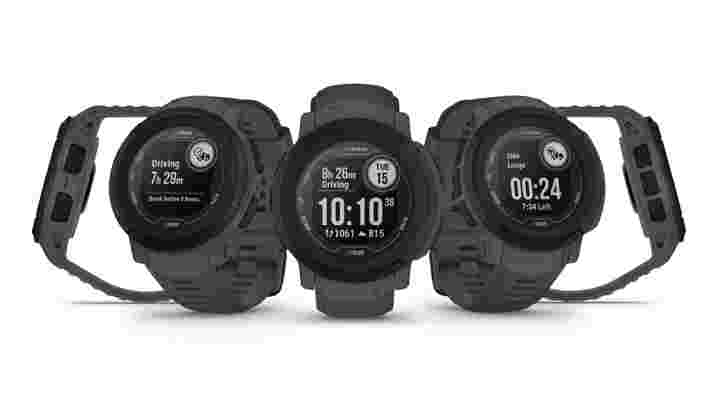
The Instinct 2 Dezl Edition pairs with those navigation systems, and allows you to set up regular break reminders that will appear on the screen. You'll also be able to see key health stats on your sat-nav's high-res display, such as heart rate and stress.
Keep on trucking
The watch will also monitor hydration, SpO2, steps, intensity minutes (time spent exercising). The Dezl smartphone app will lead you through short workouts that will help you keep active during your breaks.
Whereas most watches in the Instinct 2 line come in two sizes, the Dezl Edition is only available with a 45mm case. There's also no solar edition available, but that's a logical choice for truckers who'll be spending most of their day at the wheel.
Battery life looks impressive nonetheless; the watch can keep running for up to 28 days in smartwatch mode, up to 65 days in battery saver watch mode, and up to 30 hours with GPS enabled.
The Instinct 2 Dezl edition is available now direct from Garmin for $399.99 / £249.99 / AU$629.
What is Microsoft Teams? How it works, best features, and other resources
Microsoft Teams is a collaboration and video conferencing platform that helps people communicate effectively across a number of different mediums.
The service allows users to communicate via text chat, voice or video call and also benefits from synergies with various other Microsoft 365 services, such as OneDrive and PowerPoint .
Although Teams started out as a business application, Microsoft has recently pushed the platform as a consumer service too and, accordingly, has built it into the heart of its new Windows 11 OS.
The free version of Microsoft Teams offers a generous feature set that will be sufficient for many individuals and small businesses, while a paid version is available for larger organizations after a more comprehensive solution.
Microsoft Teams clients are available on Windows, macOS, Linux, Android and iOS, so employees can communicate using pretty much any device.
Cut to the chase
What is it? A collaboration and video conferencing service What platforms is it on? All major operating systems How much does it cost? Depends on the plan, but a free version is available Who is the target audience? Predominantly business users, but regular consumers too
Free version or paid?
The free version of Microsoft Teams boasts all the features employees will need to collaborate remotely and could be a perfectly suitable option for smaller businesses.
Unlimited text chat and search, group video conferencing, one-on-one video calls, 2GB of cloud storage per person (or 10GB across the entire team) and access to web-based versions of Word , Excel , PowerPoint and OneNote all come free of charge.
However, the free version of Microsoft Teams lacks a few important security and administration facilities - such as enforced multi-factor authentication, single sign-on and user management - that most businesses are likely to need.
If you’re looking to upgrade your Microsoft Teams subscription, there are three options available: Microsoft 365 Business Basic, Microsoft 365 Business Standard and Microsoft 365 Business Premium.
Microsoft 365 Business Basic is available for $5.00 per user per month (£3.80/AU$6.90), and includes the ability to schedule and record Microsoft Teams meetings, boosts the file storage capacity to 1TB per user and includes the additional security features mentioned above.
Office 365 Business Standard, meanwhile, costs $12.50 per user per month (£9.40/AU$17.20). It features all the benefits of the cheaper package, but also includes desktop versions of Microsoft’s famous productivity applications ( Word, Excel , PowerPoint etc.) and business apps such as Bookings, Invoicing and MileIQ.
Finally, Office 365 Premium adds advanced security and privacy features, as well as a greater range of device management options. This package will run your business $20.00 per user per month (£15.10/AU$27.50).
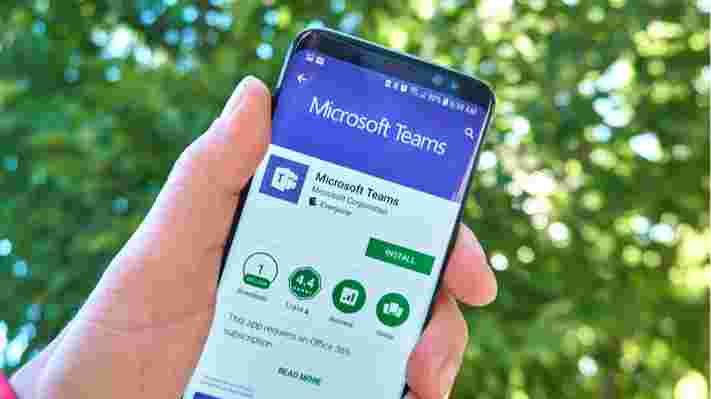
Download Microsoft Teams
To download Microsoft Teams to your device, simply follow this link to the Microsoft Teams download page .
From here, you can download the Microsoft Teams app for desktop or mobile, or you can enter your email address in the relevant field and Microsoft will deliver a download link directly.
Those looking to download Microsoft Teams mobile app can also navigate to the relevant app store on their device, be that Google Play Store or the Apple App Store.
Microsoft Teams features
Microsoft Teams offers all the core collaboration features, from high-quality video conferencing to phone calls, text chat and group messaging.
When it comes to the in-meeting experience, the service provides users with a variety of tools, such as custom and blurred backgrounds, different viewing modes, breakout rooms and text chat. Users can also share their screen during presentations, making it easier for audience members to follow along.
Teams allows meetings to be recorded, which means people unable to attend can catch up on anything they missed. And since the start of the pandemic, Microsoft has introduced a few important accessibility features too, such as live captions and transcription.
What sets Teams apart from its competitors, however, is its position within the wider Microsoft 365 suite of apps and services. For example, Teams is intertwined closely with OneDrive and SharePoint, making file-sharing easy and intuitive. An upcoming PowerPoint integration, meanwhile, is set to make managing notes during presentations and engaging with the audience less challenging.
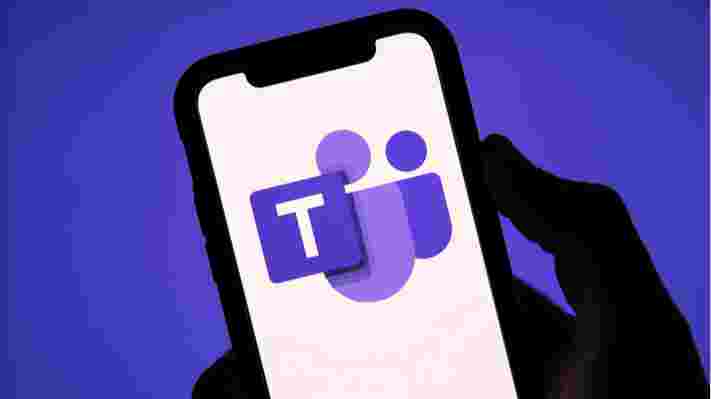
Security
When it comes to video conferencing security, end-to-end encryption (E2EE) is considered the holy grail.
Under this system, communication between meeting participants is encrypted using cryptographic keys held only on users’ devices. This means no third party, including the service provider, has access to the keys to decrypt private meeting data.
Microsoft Teams was relatively slow on the uptake where E2EE is concerned. Only recently has E2EE entered general availability for Teams calls, and even then it requires a number of features to be disabled.
That said, Microsoft has taken strong steps to prevent a practice known as “Zoombombing”, whereby an uninvited individual invades and disrupts a meeting. And the company has also added a handy disable video function that should help limit disruptions caused by legitimate attendees.
According to the Microsoft website, Teams also enforces two-factor authentication and encryption of data in transit and at rest. To ensure customers remain compliant with relevant regulations, meanwhile, Microsoft lets users make choices about the location of the data centers used to process their data in transit.
Support
As for customer service, Microsoft offers pretty much all avenues of support you might expect - with the exception of a live chat service.
The first port of call should be the extensive knowledge base , but otherwise users can seek further help via Microsoft 365 support channels, which include an online form, phone support and a dedicated Get Help app.
Microsoft Teams has native clients for all the major operating systems, including Windows, macOS, Linux, Android and iOS. Attendees can also join sessions via web browser if they please.
Other resources
12 hours with the Samsung Galaxy S22 Ultra
Smartphones are pocket-friendly computers that have far more features and depth than the communications equipment your grandparents favored. One day isn’t enough time for a full assessment of the big, powerful Samsung Galaxy S22 Ultra 5G Android 12 smartphone. But first impressions count.
Here’s a diary of my early journey full of fun discoveries, tiny disappointments, and eye-popping capabilities.

10:30 AM ET: It’s here! My Samsung Galaxy S22 Ultra 5G has arrived in a shockingly svelte black box.
10:32 AM ET: Unboxed! Gosh, there’s so little packaging in here. We have the cardboard box and the glued-in frame that holds the phone in place. Under the phone is a slim cardboard box that holds the USB-C Cable. Another cardboard band holds the cable in neat loops. That’s it.
There are no earphones (wired or unwired), and no charging brick. The phone itself has two ultra-thin pieces of plastic protecting the Corning Gorilla Glass Victus+ on the front and back of the phone.
I kind of love this minimalist approach. We don’t need reams of tiny paper manuals we’ll never read. Most of us probably already have our own favorite wireless earbuds, so I don’t really miss those, either. As for the missing charging brick, I’m torn. As a tech reviewer, I have boxes of these things, but average consumers? They might be frustrated at its omission.
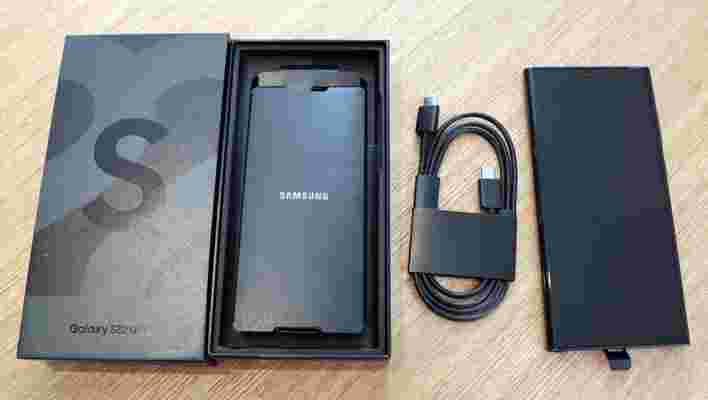
10:45 AM ET: Setup is unremarkable. It’s a combination of adding your Google credentials – I have two sets – and logging back into Samsung’s own account system and accepting various permissions. What I like about Samsung’s OneUI 4 is that the overall system feels increasingly like pure Android. Even so, I am looking forward to checking out Samsung Pay .
I can’t seem to log into my corporate Wi-Fi (an us problem, not a Samsung one). The good news is that this S22 Ultra already has a T-Mobile 5G SIM inside. The signal at my desk is pretty darn good.
11:00 AM ET: So many security choices, including Pin, Face Recognition, Fingerprints, Pattern, Password. Always interesting to me how Samsung really doesn’t recommend Face Recognition for maximum security. I start by registering my face. The set-up asks me to take off my glasses, and I immediately feel naked.
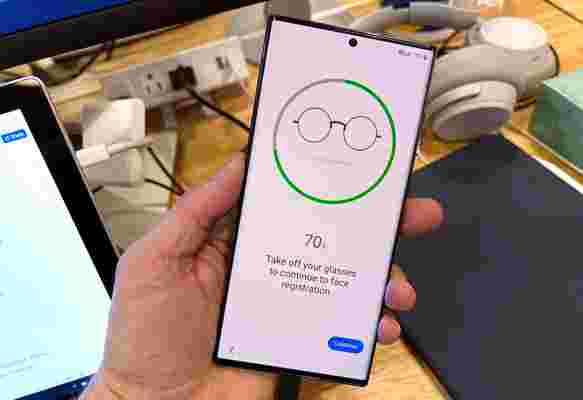
11:02 AM ET: The Samsung Galaxy S22 Ultra feels cool, slick, and substantial in my hand. I love how shiny it is and appreciate the satin back that does a decent job of hiding fingerprints. The black is killer.
Noticing how its 6.8-inch Dynamic AMOLED 2X display dwarfs my 6.1-inch iPhone 13 Pro . Later, I’ll compare it to the more comparable 6.7-inch iPhone 13 Pro Max .
It’s a weighty bugger but turns out to be slightly lighter than the iPhone 13 Pro Max.
The S22 Ultra is so slippery – the long-curved edges don’t help with grippiness. I really wish I had a case.
11:56 AM ET: I always like to get a full charge before testing. So, I plug the phone into a USB-C cable. It’s currently at about 86%. Wishing I had a 45W fast-charging brick.
12:38 PM ET: Fully charged!
12:47 PM ET: Realized I almost forgot that the S Pen now lives inside the Galaxy S22 Ultra (granted, it looks so much like a Galaxy Note device). Press the butt end of the pen until it clicks and then pops partially out. I removed the S Pen and held it. It’s quite thin and light. My hand almost feels too large to use it.
I got distracted and left the S-Pen out, sitting next to the phone. The Galaxy S22 Ultra noticed and displayed a message asking if I had inadvertently left the pen behind. That’s a nice little feature.
12:49 PM ET: Does the phone’s back feel a little warm? I swear I detect a bit of warmth on the back of the phone.
1:40 PM ET: Spent an hour outside taking photos. The zoom, especially 3x-to-10x optical, is impressive. The 30x to 100x space zoom is intriguing. It’s powerful and you can almost feel the stabilization kicking in, as the lens doesn’t really move with your hands - it tries to lock in. In 100X zoom, this can make it hard to fix on a subject without, say, a tripod. Even so, the results were so good I had to share them with you right away .
I did use the 40MP front-facing camera (portrait and regular mode). The shots look good, but why am I starting to look so much like my father?
1:50 PM ET: Smartphones don’t arrive fully baked – at least on the software side. There were, I found, a handful of software updates. I took a moment to make sure everything was as fresh as could be. Thank goodness T-Mobile’s 5G network is solid here (not as fast as Verizon’s 5G UWB , but still decent) and I’m able to download the updates and, later, apps.
1:53 PM ET: I’m a little surprised to see the Galaxy S22 Ultra’s 5,000 mAh battery is already down to 81%. This is most likely because I’m relying entirely on power-hungry 5G.
2:15 AM ET: Benchmark time! I installed Geekbench 5 to run some preliminary benchmarks. The app also gives me an opportunity to dig in a bit on the spec details. Samsung told me that they’re using a 4nm CPU that promises better base and graphics performance but didn’t tell us much else.
Geekbench tells me that the phone is running an ARM CPU with:
4Cores @ 1.79 GHz 3 Cores @ 2.50 GHz 1 Core @ 3.00 GHz
There’s a listed 9.94 GB of RAM, which is a bit confusing since Samsung lists the devices as starting with 8GB of RAM but also being offered in a 12GB of RAM variety.
On the graphics side, Geekbench 5 lists an Adreno 730 GPU.
As for the scores, on the CPU side:
Single Core: 1236 Multi-Core: 3417
On the graphics side:
OpenCL Score: 5866
For kicks, I quickly compared this to my Apple iPhone 13 Pro running Apple’s A15 Bionic. On pure CPU scores, Apple’s silicon still wins:
1681 Single Core 4551 multi-core
The picture is slightly less clear on the graphics side because Geekbench returns a Metal score for the iPhone:
Metal score 14283
My early takeaway here is that Apple still maintains the mobile CPU lead over what is likely a Qualcomm Snapdragon 8 Gen 1 chip.
2:28 PM ET: I finally added a fingerprint. Samsung told me the under-the-screen fingerprint reader is larger, thereby making it easier to use. Registration was fast and, yes, it’s pretty effective, fast,-- and even easy to reach on this big-screen phone.
2:50 PM ET: Almost all the images and video that I’ve captured thus far on the Samsung Galaxy S22 Ultra looks great. The colors pop and the action is smooth – most of it. It looks like the 8K video might have a tiny frame-rate stutter. It just doesn’t look as silky as the 1080 and 4K video I shot of Bryant Park ice skaters.
3:50 PM ET: I spend some time installing utility, social, and entertainment apps. I still remember older Android phones that made me search for Google Play (and the ones before that, which didn’t even have Google Play). Now it’s right on the home screen. Added Twitter, Instagram, and some games, like Asphalt 9, that I hope to try later.
4:43 PM ET: Oh, look, I’m down to 71% battery life. I think 5G might be eating up the battery.
5:20 PM ET: Racing through the city to catch the train, but I’m carrying the Samsung Galaxy S22 Ultra in one hand in case I want to snap a photo. I’m also gripped with fear that I might drop it – it’s so slippery. I pause on 34th Street to capture some photos of the Empire State Building. Once again, the zoom is blowing my mind.
Did I mention that Battery life is now at 68%?
5:45 PM ET: Sitting in on the train, I pop out the S Pen without unlocking the device. This enables the Screen Off Memo mode where I’m writing in a thin white line on a black background. As I’m scribbling, I hear a sound coming from the phone. It sounds like pencil on paper. Yup, each stoke is accompanied by the pencil-to-paper sound. How cool is that?
Next, I unlock the phone and start drawing in Sketchbook. The S Pen glides across the screen with every single stroke and motion captured. It’s recognizing my pressure (which is light). Not a fan of styli with physical buttons because I keep inadvertently hitting it when using the S Pen. I also wish the back end was a digital eraser, but not even Apple does that with its Apple Pencil.
The S Pen is almost too thin and light for me to comfortably draw, but then I have big hands.
I spend a little time checking and responding to email. Even with a larger virtual keyboard, I’m still a terrible thumb typist.
It also occurs to me that I’ve been using the phone with two hands. Is it really that big or am I just nervous I’ll drop it?
6:06 PM ET: Wow, the left side of the phone is noticeably warm. Sure, I’m working the phone hard -- but isn’t the new vapor chamber and heat-dissipation system supposed to keep the whole thing cool? Maybe it’s really about protecting the CPU and battery from the heat as it shunts it to the body of the Samsung Gallery S22 Ultra.
6:15 PM ET: I run a cellular speed test. The 5G performance is good: I’m getting 120 Mbps down and 67.2 Mbps upload speeds. Nice job, T-Mobile.
6:45 PM ET: It’s dark when I get home and a partial moon is directly overhead. Inspiration strikes and I snap 30x and 100x space zoom photos of the moon. The 30 in particular is kind of amazing; the 100 reminds me that digital tricks are pulling our lunar neighbor closer.
Naturally, I used the phone to post the 30x Space Zoom image on Instagram.
7:55 PM ET: I’m playing Wordle because, how could I not? The big screen is nice for games.
8:15PM ET: Discover that pressing the button on the S Pen wakes up the phone.
8:39 PM ET: I realize that there’s no macro lens and wonder why. Of course, I haven’t checked the macro capabilities of the existing 12MP Ultra-wide, 10 MP (left and right), and 108MP Wide. I’m sure a couple of those lenses can work together to give me some macro-like capabilities.
8:50 PM ET: I’m watching Elon Musk’s SpaceX spacecraft starship update on YouTube. I love the Samsung Galaxy S22 Ultra's big screen and also how I can have the picture-in-picture play on top of other apps. It made it easy to keep watching the presentation while I live-tweeted it on the same screen.
Yes, I connected a pair of Bluetooth headphones ( OnePlus Buds ) to spare my family.
9:56 PM ET: Been watching the live stream for the last hour. Now the Samsung Galaxy S22 Ultra’s power is down to 25% power.
10:14 PM ET: Bedtime, but first a few “Nightography” shots! I step outside, select “Night” from under the Camera App’s “More” menu and aim the phone at the night sky. I hold still as the long exposure captures the photos. The result is that the Samsung Galaxy S22 Ultra turned night into day. Shame there were so many clouds.
10:30 PM ET: Bedtime and the phone is ending the night with 20% battery life.
Day 1 Verdict
This was a good first day. The Samsung Galaxy S22 Ultra is a peppy and capable device that feels more like a Note than it does an S series handset. The cameras are already a highlight. Concerns remain over battery life, heat, and how easily it might slip from my hands. More to come.